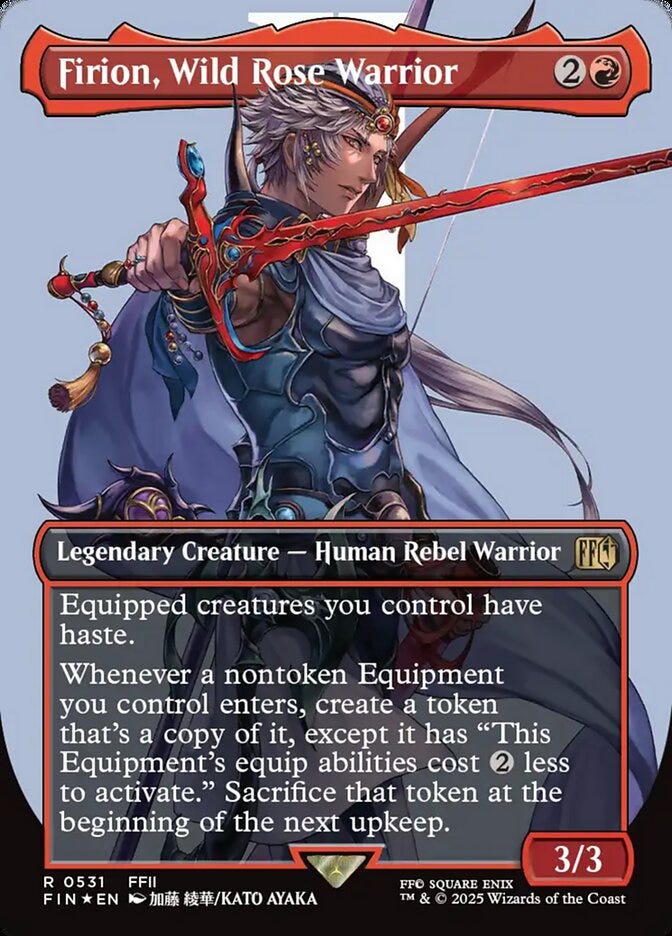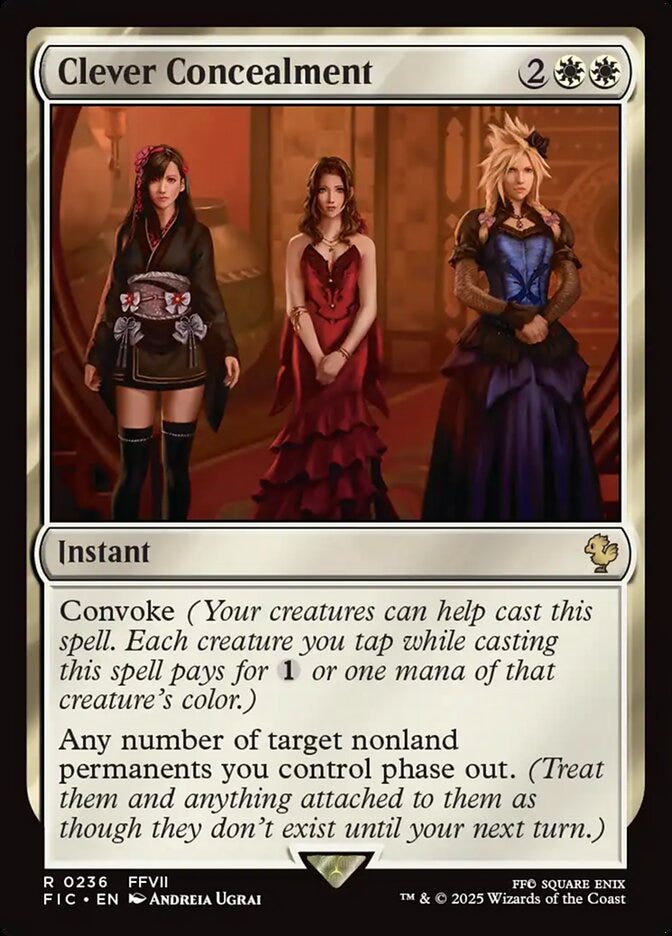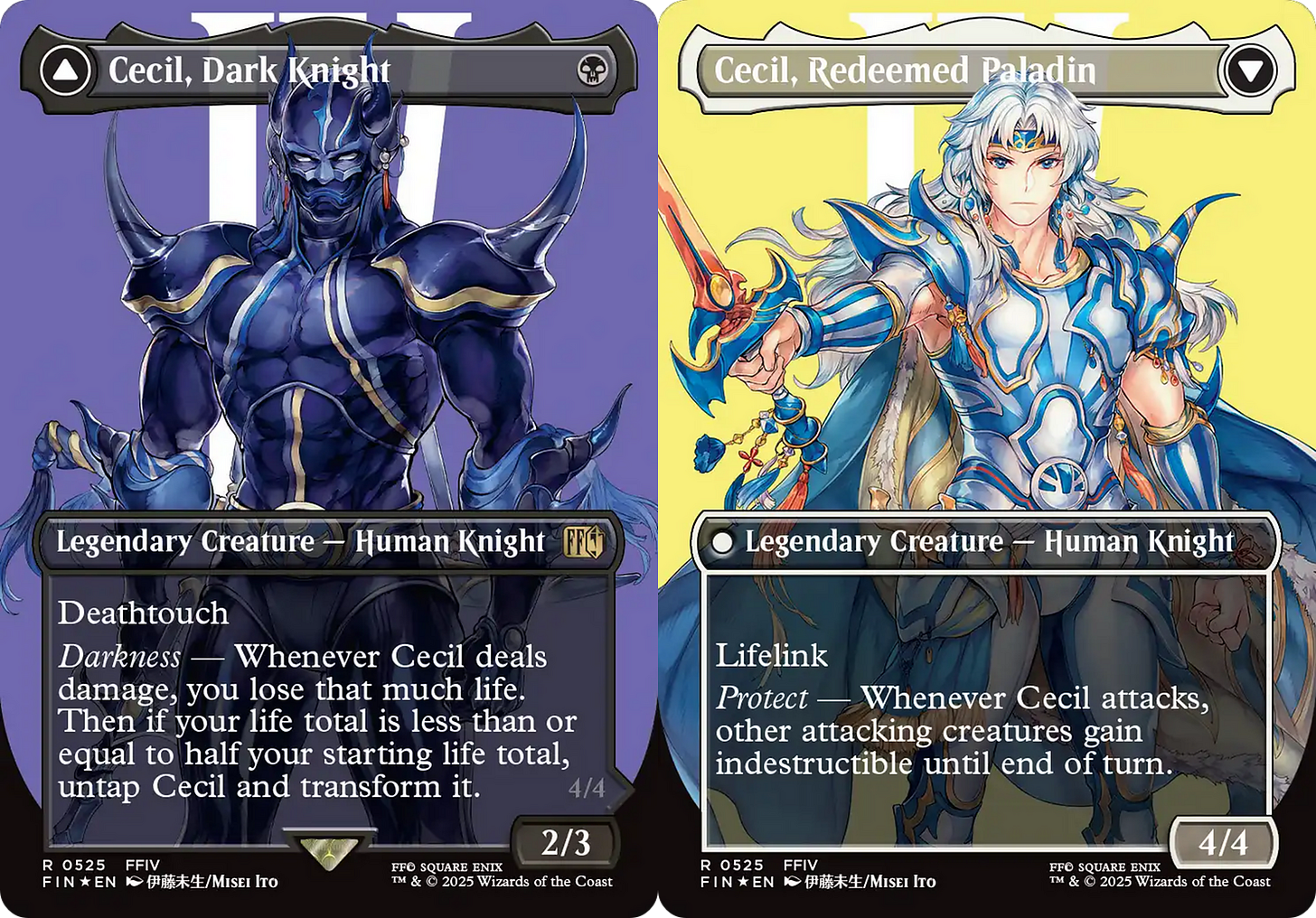Magic designers on 'Final Fantasy'
In this special edition, my full interview with the team behind Magic: The Gathering — Final Fantasy on their favorite FF games and more!
This one’s for the Magic (and Final Fantasy) freaks. I know you’re subscribed!
I couldn’t include most of what the design team behind Magic: The Gathering — Final Fantasy told me for a WBUR article I published last Friday. I’m including all their responses below, ahead of the set’s Arena release Tuesday.
Which characters provoked the most debate when it came to assigning them Magic: The Gathering colors? Were there ever instances where design necessities (draft slots, etc) forced you to push a character into a color or colors that didn't initially occur to you?
Daniel Holt, senior game designer: In Commander, cards must fit into the color identity of the face commander card. So once we decided a deck was a certain color group, every new card had to slot into that. To help guide our characters in these archetypes, we used a “snapshot in time” method. In Final Fantasy games, characters change and grow over time, so we are able to show a character anywhere in that timeline based on our need.
For example, with the Final Fantasy VI commander deck, I built it as a black-red-white graveyard deck, but characters like Celes and Gogo would want to be blue if possible. To solve for them, we leaned on Celes at the start of the second half of the game where she is determined and hopeful on getting the group back together, as opposed to focusing her spellcaster abilities. With Gogo, it was more of a twist on his play pattern. While mimicry is typically found in blue in Magic, I built his temporary and attack oriented design to be more red-aligned.
Similarly, in the Final Fantasy VII deck, there was a lot of contention on whether I could add Sephiroth or not, given the deck didn’t have black in the color identity. I felt it was important for each deck to be full game packages and you can’t have FF7 without him! So for this we leaned on that snapshot moment where he is transitioning from hero to villain as he uncovers some painful truths, resulting in the red-white design.
Gavin Verhey, principal designer & set design lead: The thing about a well-written character is that they can really display aspects of all colors at different times. So there was tons of debate, around every single character! People would even feel directly opposite at some times. Ultimately, what we came up with (as Daniel said above) is something called the “snapshot approach” —what is this character right now, in this image? And then we could get art to match that moment. We also, with characters we were doing multiple times, wanted to express multiple different color identities.
It’s also an exercise in figuring out what constraints are important, and which ones we can give way on. To give you an example of one of many color debates we had: let’s look at Noctis, Prince of Lucis, from Final Fantasy XV. There was a lot to weigh here. He’s a hero on a journey, he has a bit of an ambitious and troubled past, he’s smart and resourceful, but also very strong. That begins to suggest some colors. He also hangs out with his three friends in his party for most of the game. Should they all be the same colors so they could go in the same commander deck together? But then what about those characters' more natural feeling colors?
Ultimately, we decided that the goal of having them all in the same commander deck was going to cause less creatively satisfying colors to match their personalities so we let that need go. That said, we kept it in mind and put a five-color identity Noctis on the FCA [Through the Ages] bonus sheet, as a reprint of Kenrith, the Returned King, so folks who wanted Noctis at the helm with his pals could still do that!
What reactions from Final Fantasy fans have most surprised you?
Holt: The team here at Wizards of the Coast have been working on this set for over four years now, and the whole building is filled with passionate fans of the series. A lot of love went into developing this set internally!
Naturally, I hoped it would be the case, but seeing players delighted by the decisions we made on what to include has truly made it all worth it. The overwhelmingly positive reception has blown us away.
But to answer the question, and maybe it’s a bit cheesy, but I think the “most surprising” reaction I’ve seen is just how much players appreciate the little details of the series included, truly validating the effort the various teams put into the set. Not just main party characters, but side characters and mascots like Jumbo Cactuar have been fan favorites! There’s also been appreciation for story moments portrayed on new cards like Suplex and Sidequest: Catch a Fish or reprints in the Commander decks like ‘Cloud in a dress’ on Clever Concealment and “the laughing scene from FF10” on Inspiring Call
Verhey: There have been so many favorite moments it’s hard to count! What a journey the set has had here after so many years of development, and it’s an incredible release to see the set finally out and people so thrilled about it!
I think the thing I’ve been happiest to see are all the comments from fans of so many different games. It’s really great hearing how much every game has fans and people being excited to see the characters they love – especially ones that came out a long time ago. Hearing people excited to try out Firion from Final Fantasy II 27 years after it originally released in Japan is so cool! I wish I could have made legendary cards for every Final Fantasy character — there’s just so much to cover. But I’m proud of the wide spread we managed in a single set!
Dillon Deveney, principal game designer: I have been absolutely blown away by the number of threads I have read that are massive deep dives into the scene, lore, story, and characterization of moments depicted on cards. It’s amazing! Like, I expected people to be happy to see their favorite moments, but fans are going above and beyond to analyze and explain the translation from Final Fantasy into MTG.
Especially fans who are familiar with both. I’ve seen so many comments from non-FF fans who ask about the context or story of a character or card, and the Final Fantasy fans come in with essays of text about how cool or awesome that thing is. It's such a kind invitation and insight into this collaboration. I love it when people get a chance to talk about the things they love, and especially when they get a chance to share it and celebrate it. The lands too, I’ve loved watching people look through the lands and basic lands and find where we decided to capture these locations. Keep it up, folks!
What input did Square Enix have in the actual design of the cards, beyond collaborating on the art?
Verhey: One thing about working with Square is the team we were working with were huge Magic fans! We have a weekly call with Square every Tuesday night, and I remember calling into my first one of these and they were telling me about how they played four prereleases the previous weekend and just got new cards for their modern decks – so they’re very into Magic!
So, as huge Magic fans, I really welcomed their feedback. We went over to Japan and playtested at the Square Enix offices (talk about a dream come true!) and as the set was wrapping up they sent feedback on all the rares and mythics in the set, which was great as well. While card text decisions were ultimately the final call of me and Game Design, on such a collaborative product as this one I really welcomed their notes —nobody knows Final Fantasy better than they do!
Additionally, and Dillon can speak to this some as well, but we worked very close with them on all creative elements. All the creature types, names, flavor text, and so on were all things Square looked at and made sure were good fits for them, and offered suggestions as well.
Deveney: The great folks over at Square Enix were champions through and through. They were with us every step of the way, and I had the good fortune to work alongside each Title Owner and review team to ensure each game was hitting the most accurate, flavorful, and authentic moments when translating their game into ours. We would come up with what we wanted to name cards, what creature types would make the most sense to our players, and what quotes we wanted to use on the cards.
Then, from their perspective, they would give us feedback on how they view the characters, how they saw the story, what their fans react positively to, and would point out any distinctions or differences between the English and Japanese localizations that might affect card names, flavor text, and creature type decisions. With their wisdom and feedback, we would iterate, then move onto the next title in the series. Everyone over at Square Enix saw that we were giving this project our all and really put their full effort and attention into this collaboration.
How did past experiences designing land archetypes like deserts and Gates influence the Towns draft archetype?
Verhey: As a big gate fan myself, I can say quite a bit. Originally when the set was handed off to me, common towns as lands were in the set but they did something different and were quite complex – basically, they were lands with “modal” (meaning, pick one of three things) abilities when you played them. While the flavor was nice of going to the town and getting whatever you needed, they were really not the right fit for commons in the set.
So we kept doing some iteration, and ultimately my idea was that gates are fun — what if we just did something like gates? And so we ended up going down that path. Return to Ravnica, the set that premiered gates, was the first set I ever worked on at Wizards so it has a special place in my heart. I even was inspired by Gatecreeper Vine to make Town Greeter, as a two-drop for the town deck. So good eye and comparison!
Finally, which Final Fantasy games are your personal favorites (even among spinoff games like Tactics that didn't get featured in this product)?
Holt: My personal favorite game in the series is Final Fantasy X. It was the first in the series to include voice acting and really showed off the graphics possible on the PS2, and I’m sure anyone who has played it fondly remembers scenes like Yuna’s sending, Tidus laughing, and of course, plenty of Blitzball. Tidus was even one of the first characters I cosplayed as for a local anime convention in high school. So when I was asked to lead the commander product, I obviously pushed for FF10 to be one of the four deck themes.
Verhey: Final Fantasy IX is my favorite mainline game in the franchise. I love the return to a high fantasy story, the whimsy, the characters and of course the black mages. Vivi is a favorite character of mine!
Outside of mainline games, Final Fantasy Tactics Advance is a game I put so, so, SO many hours into. I used to do these long road trips with my family growing up, and that kept me entertained endlessly. As a turn based strategy game to someone who already loved Magic, well, let’s just say it was a perfect fit!
Deveney: My favorite Final Fantasy game is Final Fantasy IV! This game means a lot to me and was one of the games that inspired my earliest interest in narrative game design. Cecil’s journey from the Dark Knight who only follows orders into a redeemed Paladin who fights for what’s right with his own code was outstanding to me as a kid. The fact that my character’s sprite visually changed and my mechanics changed — like what?!
Amazing stuff — with an amazing cast of characters, great villains, great worldbuilding. I could go on! Much like Gavin, my favorite Final Fantasy game outside of the collaboration is Final Fantasy Tactics Advance. This game was released when I was extremely sick and it's absolutely the reason I was able to get through that illness. I poured my entire life into that game and fell in love with Ivalice, the job system, the story (which paralleled some of what I was going through at the time.) Despite being so incredibly sick, I can only recall the good times that Tactics gave me.













